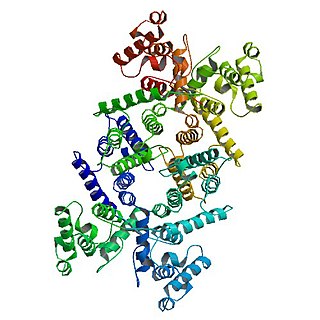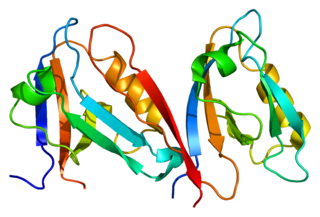Dystrobrevin alpha is a protein that in humans is encoded by the DTNA gene. [5] [6] [7]
Dystrobrevin alpha is a protein that in humans is encoded by the DTNA gene. [5] [6] [7]
The protein encoded by this gene belongs to the dystrobrevin subfamily and the dystrophin family. This protein is a component of the dystrophin-associated protein complex (DPC). The DPC consists of dystrophin and several integral and peripheral membrane proteins, including dystroglycans, sarcoglycans, syntrophins and alpha- and beta-dystrobrevin. The DPC localizes to the sarcolemma and its disruption is associated with various forms of muscular dystrophy. This protein may be involved in the formation and stability of synapses as well as the clustering of nicotinic acetylcholine receptors. Multiple alternatively spliced transcript variants encoding different isoforms have been identified. [7]
Mutations in DTNA are associated with Ménière's disease. [8] [9]
Dystrobrevin has been shown to interact with dystrophin. [10]

Dystrophin is a rod-shaped cytoplasmic protein, and a vital part of a protein complex that connects the cytoskeleton of a muscle fiber to the surrounding extracellular matrix through the cell membrane. This complex is variously known as the costamere or the dystrophin-associated protein complex (DAPC). Many muscle proteins, such as α-dystrobrevin, syncoilin, synemin, sarcoglycan, dystroglycan, and sarcospan, colocalize with dystrophin at the costamere. It has a molecular weight of 427 kDa
Derek Blake was, until 2007, the Isobel Laing Post-Doctoral Fellow in Biomedical Sciences, and the Wellcome Trust Senior Fellow in Basic Biomedical Science, Oriel College, Oxford.

Dysferlin also known as dystrophy-associated fer-1-like protein is a protein that in humans is encoded by the DYSF gene. Dysferlin is linked with plasma membrane repair., stabilization of calcium signaling and the development of the T-tubule system of the muscle A defect in the DYSF gene, located on chromosome 2p12-14, results in several types of muscular dystrophy; including Miyoshi myopathy (MM), Limb-girdle muscular dystrophy type 2B (LGMD2B) and Distal Myopathy (DM). A reduction or absence of dysferlin, termed dysferlinopathy, usually becomes apparent in the third or fourth decade of life and is characterised by weakness and wasting of various voluntary skeletal muscles. Pathogenic mutations leading to dysferlinopathy can occur throughout the DYSF gene.

Caveolin-3 is a protein that in humans is encoded by the CAV3 gene. Alternative splicing has been identified for this locus, with inclusion or exclusion of a differentially spliced intron. In addition, transcripts utilize multiple polyA sites and contain two potential translation initiation sites.

Utrophin is a protein that in humans is encoded by the UTRN gene. The name is a short form for ubiquitous dystrophin.

Dysbindin, short for dystrobrevin-binding protein 1, is a protein constituent of the dystrophin-associated protein complex (DPC) of skeletal muscle cells. It is also a part of BLOC-1, or biogenesis of lysosome-related organelles complex 1. Dysbindin was discovered by the research group of Derek Blake via yeast two-hybrid screening for binding partners of α-dystrobrevin. In addition, dysbindin is found in neural tissue of the brain, particularly in axon bundles and especially in certain axon terminals, notably mossy fiber synaptic terminals in the cerebellum and hippocampus. In humans, dysbindin is encoded by the DTNBP1 gene.

Sarcospan is a protein that in humans is encoded by the SSPN gene.
Dystrobrevin is a protein that binds to dystrophin in the costamere of skeletal muscle cells. In humans, there are at least two isoforms of dystrobrevin, dystrobrevin alpha and dystrobrevin beta.

Alpha-1-syntrophin is a protein that in humans is encoded by the SNTA1 gene. Alpha-1 syntrophin is a signal transducing adaptor protein and serves as a scaffold for various signaling molecules. Alpha-1 syntrophin contains a PDZ domain, two Pleckstrin homology domain and a 'syntrophin unique' domain.

Beta-sarcoglycan is a protein that in humans is encoded by the SGCB gene.

Delta-sarcoglycan is a protein that in humans is encoded by the SGCD gene.

Beta-2-syntrophin is a protein that in humans is encoded by the SNTB2 gene.

Alpha-sarcoglycan is a protein that in humans is encoded by the SGCA gene.

Gamma-sarcoglycan is a protein that in humans is encoded by the SGCG gene. The α to δ-sarcoglycans are expressed predominantly (β) or exclusively in striated muscle. A mutation in any of the sarcoglycan genes may lead to a secondary deficiency of the other sarcoglycan proteins, presumably due to destabilisation of the sarcoglycan complex. The disease-causing mutations in the α to δ genes cause disruptions within the dystrophin-associated protein (DAP) complex in the muscle cell membrane. The transmembrane components of the DAP complex link the cytoskeleton to the extracellular matrix in adult muscle fibres, and are essential for the preservation of the integrity of the muscle cell membrane.

Beta-1-syntrophin is a protein that in humans is encoded by the SNTB1 gene.

Homeobox protein SIX5 is a protein that in humans is encoded by the SIX5 gene.

Gamma-1-syntrophin is a protein that in humans is encoded by the SNTG1 gene.

Dystrobrevin beta is a protein which in humans is encoded by the DTNB gene.
Louis Martens Kunkel is an American geneticist and member of the National Academy of Sciences (NAS). His father and grandfather were also scientists and NAS members. Kunkel came from a Lutheran background and attended Lutheran schools in youth. He later graduated from Gettysburg College in 1971. He obtained his PhD from Johns Hopkins University. He is noted for discovering dystrophin, which is relevant to muscular dystrophy research.